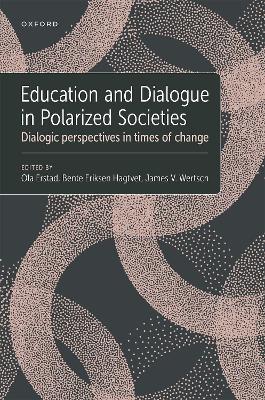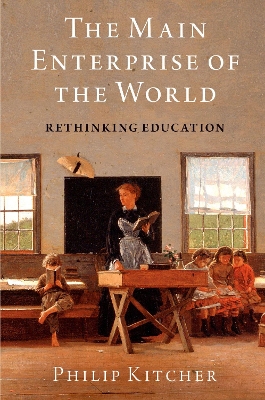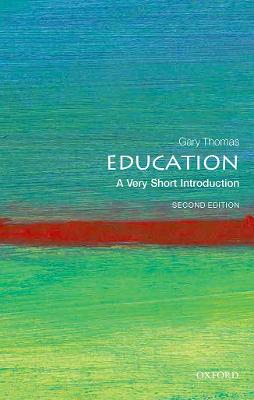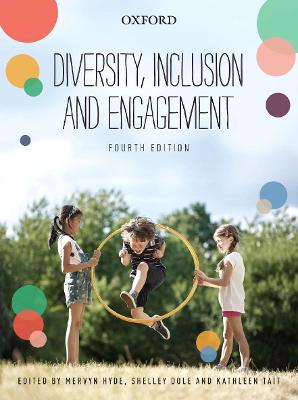Education and Dialogue in Polarized Societies
 -10%
portes grátis
-10%
portes grátis
Education and Dialogue in Polarized Societies
Dialogic perspectives in times of change
Hagtvet, Bente E.; Erstad, Ola; Wertsch, James V.
Oxford University Press Inc
08/2024
320
Dura
9780197605424
15 a 20 dias
Descrição não disponível.
Chapter 1 The Importance of Dialogue
1.1 Introduction
1.2 The importance of dialogue
1.3 The current dominance of monologic approaches
1.4 The dialogical rationale of this book: Key theoretical positions.
1.5 Dialogue and learning
1.6 The structure of the book
SECTION 1: THE LEGACY OF ROMMETVEIT
Chapter 2 The Role of Narratives in Dialogue and Intersubjectivity
2.1 Introduction
2.2 The influence of Rommetveit
2.3 Narrative as a Symbolic Tool
2.4 American National Narratives as Co-authors
2.5 Competing Narrative Templates
2.6 Dialogism, Intersubjectivity, and Narratives
Chapter 3 Ragnar Rommetveit on Contextures and Partially Shared Understandings
3.1 Introduction
3.2 Ragnar Rommetveit
3.3 On Rommetveit?s early attempts to describe contexts of languaging
3.4 Authentic situations I: Threatening phone calls
3.5 Authentic situations II: Situations suggesting sexual abuse of children
3.6 Authentic situations III: Hannah Arendt about Adolf Eichmann in Jerusalem
3.7 Authentic example IV: Putin?s on the war in Ukraine
3.8 On remote contexts and lost opportunities
3.9 Context atrophy in formal linguistics and in myopic interaction analysis
3.10 Coda: A note on macro-level phenomena
Chapter 4 Layered Attunement: Internal dialogues of intersubjectivity
4.1 Introduction
4.2 Dialogical negotiation beyond consciousness
4.3 The Polysemic Multivoiced Self (PMS)
4.4 Relations between voices: tensions and their negotiation
4.5 General Discussion: Learning with Rommetveit
SECTION 2: SOCIETAL CONDITONS FOR DIALOGUE AND THE ROLE OF EDUCATION
Chapter 5 The Limits and Potential of Dialogue to counter Polarization in Educative settings
5.1 Introduction: is dialogue disabled in polarized settings?
5.2 Dialogue as a remedy of polarization - the UNION project
5.3 What can dialogue do in situations of polarization according to the theory?
5.3.1 Can we design inclusive dialogical spaces for communities that are diverse?
5.3.2 (How) can dialogue function between parties with rival or incommensurable worldviews?
5.3.3 What can we learn from the very nature of intersubjectivty and its ability to bridge opposing worlds?
5.4 Implications for designing dialogical interventions
5.4.1 Design principles for dialogical interventions
5.5 Concluding thoughts: the need to go back to the rough ground
Chapter 6 Active citizenship and participation through
1.1 Introduction
1.2 The importance of dialogue
1.3 The current dominance of monologic approaches
1.4 The dialogical rationale of this book: Key theoretical positions.
1.5 Dialogue and learning
1.6 The structure of the book
SECTION 1: THE LEGACY OF ROMMETVEIT
Chapter 2 The Role of Narratives in Dialogue and Intersubjectivity
2.1 Introduction
2.2 The influence of Rommetveit
2.3 Narrative as a Symbolic Tool
2.4 American National Narratives as Co-authors
2.5 Competing Narrative Templates
2.6 Dialogism, Intersubjectivity, and Narratives
Chapter 3 Ragnar Rommetveit on Contextures and Partially Shared Understandings
3.1 Introduction
3.2 Ragnar Rommetveit
3.3 On Rommetveit?s early attempts to describe contexts of languaging
3.4 Authentic situations I: Threatening phone calls
3.5 Authentic situations II: Situations suggesting sexual abuse of children
3.6 Authentic situations III: Hannah Arendt about Adolf Eichmann in Jerusalem
3.7 Authentic example IV: Putin?s on the war in Ukraine
3.8 On remote contexts and lost opportunities
3.9 Context atrophy in formal linguistics and in myopic interaction analysis
3.10 Coda: A note on macro-level phenomena
Chapter 4 Layered Attunement: Internal dialogues of intersubjectivity
4.1 Introduction
4.2 Dialogical negotiation beyond consciousness
4.3 The Polysemic Multivoiced Self (PMS)
4.4 Relations between voices: tensions and their negotiation
4.5 General Discussion: Learning with Rommetveit
SECTION 2: SOCIETAL CONDITONS FOR DIALOGUE AND THE ROLE OF EDUCATION
Chapter 5 The Limits and Potential of Dialogue to counter Polarization in Educative settings
5.1 Introduction: is dialogue disabled in polarized settings?
5.2 Dialogue as a remedy of polarization - the UNION project
5.3 What can dialogue do in situations of polarization according to the theory?
5.3.1 Can we design inclusive dialogical spaces for communities that are diverse?
5.3.2 (How) can dialogue function between parties with rival or incommensurable worldviews?
5.3.3 What can we learn from the very nature of intersubjectivty and its ability to bridge opposing worlds?
5.4 Implications for designing dialogical interventions
5.4.1 Design principles for dialogical interventions
5.5 Concluding thoughts: the need to go back to the rough ground
Chapter 6 Active citizenship and participation through
Este título pertence ao(s) assunto(s) indicados(s). Para ver outros títulos clique no assunto desejado.
Chapter 1 The Importance of Dialogue
1.1 Introduction
1.2 The importance of dialogue
1.3 The current dominance of monologic approaches
1.4 The dialogical rationale of this book: Key theoretical positions.
1.5 Dialogue and learning
1.6 The structure of the book
SECTION 1: THE LEGACY OF ROMMETVEIT
Chapter 2 The Role of Narratives in Dialogue and Intersubjectivity
2.1 Introduction
2.2 The influence of Rommetveit
2.3 Narrative as a Symbolic Tool
2.4 American National Narratives as Co-authors
2.5 Competing Narrative Templates
2.6 Dialogism, Intersubjectivity, and Narratives
Chapter 3 Ragnar Rommetveit on Contextures and Partially Shared Understandings
3.1 Introduction
3.2 Ragnar Rommetveit
3.3 On Rommetveit?s early attempts to describe contexts of languaging
3.4 Authentic situations I: Threatening phone calls
3.5 Authentic situations II: Situations suggesting sexual abuse of children
3.6 Authentic situations III: Hannah Arendt about Adolf Eichmann in Jerusalem
3.7 Authentic example IV: Putin?s on the war in Ukraine
3.8 On remote contexts and lost opportunities
3.9 Context atrophy in formal linguistics and in myopic interaction analysis
3.10 Coda: A note on macro-level phenomena
Chapter 4 Layered Attunement: Internal dialogues of intersubjectivity
4.1 Introduction
4.2 Dialogical negotiation beyond consciousness
4.3 The Polysemic Multivoiced Self (PMS)
4.4 Relations between voices: tensions and their negotiation
4.5 General Discussion: Learning with Rommetveit
SECTION 2: SOCIETAL CONDITONS FOR DIALOGUE AND THE ROLE OF EDUCATION
Chapter 5 The Limits and Potential of Dialogue to counter Polarization in Educative settings
5.1 Introduction: is dialogue disabled in polarized settings?
5.2 Dialogue as a remedy of polarization - the UNION project
5.3 What can dialogue do in situations of polarization according to the theory?
5.3.1 Can we design inclusive dialogical spaces for communities that are diverse?
5.3.2 (How) can dialogue function between parties with rival or incommensurable worldviews?
5.3.3 What can we learn from the very nature of intersubjectivty and its ability to bridge opposing worlds?
5.4 Implications for designing dialogical interventions
5.4.1 Design principles for dialogical interventions
5.5 Concluding thoughts: the need to go back to the rough ground
Chapter 6 Active citizenship and participation through
1.1 Introduction
1.2 The importance of dialogue
1.3 The current dominance of monologic approaches
1.4 The dialogical rationale of this book: Key theoretical positions.
1.5 Dialogue and learning
1.6 The structure of the book
SECTION 1: THE LEGACY OF ROMMETVEIT
Chapter 2 The Role of Narratives in Dialogue and Intersubjectivity
2.1 Introduction
2.2 The influence of Rommetveit
2.3 Narrative as a Symbolic Tool
2.4 American National Narratives as Co-authors
2.5 Competing Narrative Templates
2.6 Dialogism, Intersubjectivity, and Narratives
Chapter 3 Ragnar Rommetveit on Contextures and Partially Shared Understandings
3.1 Introduction
3.2 Ragnar Rommetveit
3.3 On Rommetveit?s early attempts to describe contexts of languaging
3.4 Authentic situations I: Threatening phone calls
3.5 Authentic situations II: Situations suggesting sexual abuse of children
3.6 Authentic situations III: Hannah Arendt about Adolf Eichmann in Jerusalem
3.7 Authentic example IV: Putin?s on the war in Ukraine
3.8 On remote contexts and lost opportunities
3.9 Context atrophy in formal linguistics and in myopic interaction analysis
3.10 Coda: A note on macro-level phenomena
Chapter 4 Layered Attunement: Internal dialogues of intersubjectivity
4.1 Introduction
4.2 Dialogical negotiation beyond consciousness
4.3 The Polysemic Multivoiced Self (PMS)
4.4 Relations between voices: tensions and their negotiation
4.5 General Discussion: Learning with Rommetveit
SECTION 2: SOCIETAL CONDITONS FOR DIALOGUE AND THE ROLE OF EDUCATION
Chapter 5 The Limits and Potential of Dialogue to counter Polarization in Educative settings
5.1 Introduction: is dialogue disabled in polarized settings?
5.2 Dialogue as a remedy of polarization - the UNION project
5.3 What can dialogue do in situations of polarization according to the theory?
5.3.1 Can we design inclusive dialogical spaces for communities that are diverse?
5.3.2 (How) can dialogue function between parties with rival or incommensurable worldviews?
5.3.3 What can we learn from the very nature of intersubjectivty and its ability to bridge opposing worlds?
5.4 Implications for designing dialogical interventions
5.4.1 Design principles for dialogical interventions
5.5 Concluding thoughts: the need to go back to the rough ground
Chapter 6 Active citizenship and participation through
Este título pertence ao(s) assunto(s) indicados(s). Para ver outros títulos clique no assunto desejado.







